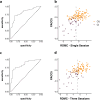A remote digital memory composite to detect cognitive impairment in memory clinic samples in unsupervised settings using mobile devices
- PMID: 38532080
- PMCID: PMC10965892
- DOI: 10.1038/s41746-024-00999-9
A remote digital memory composite to detect cognitive impairment in memory clinic samples in unsupervised settings using mobile devices
Abstract
Remote monitoring of cognition holds the promise to facilitate case-finding in clinical care and the individual detection of cognitive impairment in clinical and research settings. In the context of Alzheimer's disease, this is particularly relevant for patients who seek medical advice due to memory problems. Here, we develop a remote digital memory composite (RDMC) score from an unsupervised remote cognitive assessment battery focused on episodic memory and long-term recall and assess its construct validity, retest reliability, and diagnostic accuracy when predicting MCI-grade impairment in a memory clinic sample and healthy controls. A total of 199 participants were recruited from three cohorts and included as healthy controls (n = 97), individuals with subjective cognitive decline (n = 59), or patients with mild cognitive impairment (n = 43). Participants performed cognitive assessments in a fully remote and unsupervised setting via a smartphone app. The derived RDMC score is significantly correlated with the PACC5 score across participants and demonstrates good retest reliability. Diagnostic accuracy for discriminating memory impairment from no impairment is high (cross-validated AUC = 0.83, 95% CI [0.66, 0.99]) with a sensitivity of 0.82 and a specificity of 0.72. Thus, unsupervised remote cognitive assessments implemented in the neotiv digital platform show good discrimination between cognitively impaired and unimpaired individuals, further demonstrating that it is feasible to complement the neuropsychological assessment of episodic memory with unsupervised and remote assessments on mobile devices. This contributes to recent efforts to implement remote assessment of episodic memory for case-finding and monitoring in large research studies and clinical care.
© 2024. The Author(s).
Conflict of interest statement
D.B. reports personal fees from neotiv GmbH during the conduct of the study. O.V.B., I.H., M.H.N., and N.D. are full employees of neotiv GmbH and report personal fees from neotiv GmbH during the conduct of the study. S.T. reports Advisory Board Membership for Biogen, Roche, and Grifols. J.W. reports personal fees from Abbott, Biogen, Boehringer-Ingelheim, Eli Lilly, MSD SHARP Dohme, Roche, Janssen Cilag, Immunogenetics, Roboscreen, and Pfizer during the conduct of the study. S.C.J. has, in the past 2 years, served on advisory boards to Roche Diagnostics, Prothena, AlzPath, Merck and Eisai. His institution has received research funding from Cerveau Technologies. E.D. reports personal fees from neotiv GmbH during the conduct of the study and personal fees from Biogen, Roche, Lilly, Eisai, and UCL Consultancy, as well as non-financial support from Rox Health outside the submitted work. D.B. and E.D. are co-founders of neotiv GmbH and own company shares. W.G., X.G., J.G., M.H.N., M.B., A. Sp, A.S., K.B., M.W., R.P., and F.J., L.C., K.B. have no competing interest to disclose.
Figures




References
-
- Costa A, et al. The need for harmonisation and innovation of neuropsychological assessment in neurodegenerative dementias in Europe: consensus document of the Joint Program for Neurodegenerative Diseases Working Group. Alzheimer’s Res. Ther. 2017;9:27. doi: 10.1186/s13195-017-0254-x. - DOI - PMC - PubMed
LinkOut - more resources
Full Text Sources

